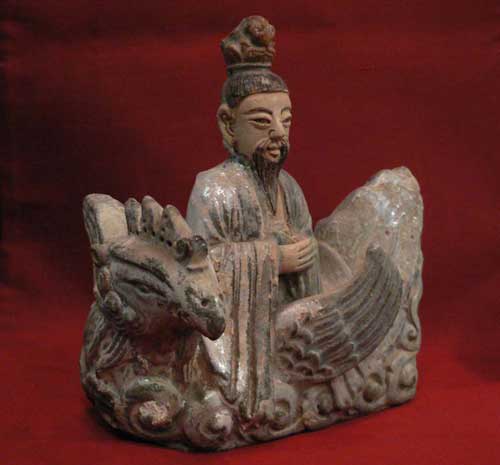Glazed Pottery Figurine of a Daoist Immortal on a Phoenix, 1368 CE - 1644 CE
Terracotta
7.5
LA.520
Iridescent green lead glazed roof tile finial depicting a Daoist immortal riding a phoenix, with hands gathered as to hold a tablet, his hair tied up under a four-petals cap,...
Iridescent green lead glazed roof tile finial depicting a Daoist immortal riding a phoenix, with hands gathered as to hold a tablet, his hair tied up under a four-petals cap, his facial traits clearly delineated with long slanted eyes and pointed beard. The phoenix with head turned to one side, wings spread and high tail.
In Chinese classical art and literature, phoenix often served as metaphor for people of high virtue and rare talent, while in combination with the dragon often alluded to blissful marriage and even to Imperial couple.
Furthermore in Daoist iconography, phoenix and immortals often are depicted together. In this case the connubial composition might indeed allude to one of the four heavenly ministers, specifically the South Pole Emperor of the South (chin.: Nanji Changsheng Dadi) who would supervise all things and creatures of the southern cardinal pole.
According to traditional cosmogony, the south was associated with the phoenix and her appearance in conjunction with the South Pole Emperor would seem to confirm this metaphor. Images of the heavenly ministers are known from traditional folk paintings and prints and they all feature a bearded high official portrayed frontally and holding the tablets with both hands, in exactly the same posture of our figurine.
The shape of the tile would further suggest that it was possibly placed on the southern corner of the temple roof.
In Chinese classical art and literature, phoenix often served as metaphor for people of high virtue and rare talent, while in combination with the dragon often alluded to blissful marriage and even to Imperial couple.
Furthermore in Daoist iconography, phoenix and immortals often are depicted together. In this case the connubial composition might indeed allude to one of the four heavenly ministers, specifically the South Pole Emperor of the South (chin.: Nanji Changsheng Dadi) who would supervise all things and creatures of the southern cardinal pole.
According to traditional cosmogony, the south was associated with the phoenix and her appearance in conjunction with the South Pole Emperor would seem to confirm this metaphor. Images of the heavenly ministers are known from traditional folk paintings and prints and they all feature a bearded high official portrayed frontally and holding the tablets with both hands, in exactly the same posture of our figurine.
The shape of the tile would further suggest that it was possibly placed on the southern corner of the temple roof.
